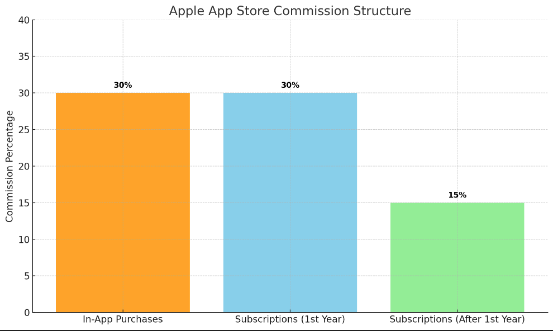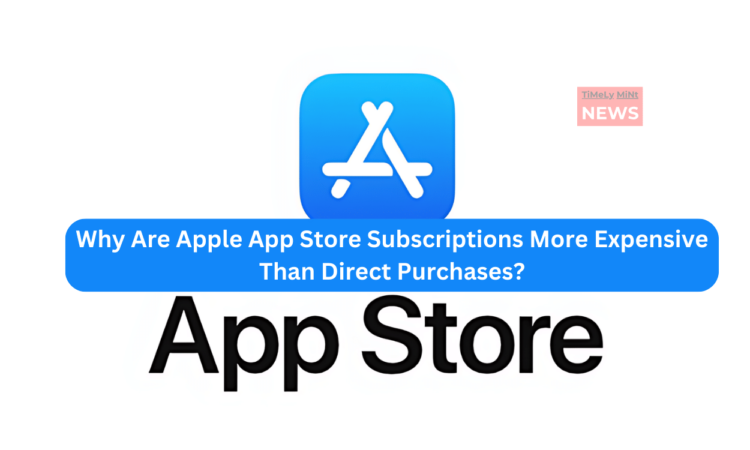If you’ve ever wondered why subscriptions and in-app purchases on the Apple App Store often come with a heftier price tag compared to buying directly from the developer or on non-Apple devices, you’re not alone. This phenomenon has been a topic of discussion among consumers and developers alike, as it impacts both the user experience and the app ecosystem as a whole.
In this article, we’ll dive into the reasons behind these price differences, explore the implications for developers and users, and discuss potential alternatives and future developments in the app marketplace.
Understanding Apple’s App Store Commission Structure
At the heart of the issue lies Apple’s commission structure for the App Store. When a user makes an in-app purchase or subscribes to a service through an iOS app, Apple takes a substantial cut of the revenue. Here’s how it breaks down:
| Purchase Type | Apple’s Commission |
|---|---|
| In-App Purchases | 30% |
| Subscriptions (First Year) | 30% |
| Subscriptions (After First Year) | 15% |

This commission structure has a significant impact on developer revenue and, consequently, their pricing strategies. To offset the loss of revenue to Apple’s commission, many developers choose to pass on the cost to consumers by raising prices on the App Store.
The Mandatory Use of Apple’s In-App Purchase System
Another factor contributing to higher prices on the App Store is the requirement for apps to use Apple’s in-app purchase system for digital goods and services. This policy limits developers’ ability to direct users to external, potentially cheaper payment options.
In contrast, Android and other platforms often have more flexible policies, allowing developers to use alternative payment systems or link to external websites for purchases. This flexibility enables developers to offer lower prices outside of the App Store.
The Impact of App Store Guidelines and Review Process
Apple’s strict App Store guidelines and review process can also influence the pricing and features of iOS apps. These guidelines may limit the functionality or content that developers can include in their apps, sometimes resulting in higher-priced iOS versions compared to their Android counterparts.
For example, a popular subscription-based app might offer a more comprehensive feature set on Android due to the platform’s less restrictive policies, while the iOS version might have a more limited set of features at a higher price point.
Developer Strategies to Offset Commission Costs
To mitigate the impact of Apple’s commissions on their revenue, developers employ various strategies:
- Passing on the cost to consumers: Many developers choose to set higher prices for their iOS apps to account for the 15-30% commission they must pay to Apple.
- Offering direct purchases at lower prices: Some developers encourage users to purchase subscriptions or content directly from their website, where they can offer lower prices without the burden of App Store commissions.
- Implementing alternative payment systems: Despite the challenges and limitations posed by App Store guidelines, some developers are exploring ways to integrate alternative payment options into their apps.
Potential Alternatives and Future Developments
Recent legal rulings, such as the landmark case between Epic Games and Apple, have challenged the status quo of Apple’s App Store policies. These developments have prompted discussions about potential alternatives and changes to the current system:
- Third-party payment systems: Companies like Paddle and RevenueCat are developing tools that allow developers to manage subscriptions and process payments outside the App Store, potentially enabling them to offer lower prices to consumers.
- Changes to Apple’s commission structure: In response to legal pressures and developer feedback, Apple may be compelled to modify its commission structure or allow for more flexibility in payment options.
- Increased competition and consumer choice: As developers explore alternative app marketplaces and payment systems, consumers may benefit from increased competition and more choices when it comes to purchasing apps and subscriptions.
US Department of Justice Filed Antitrust Lawsuit Against Apple
The United States Department of Justice (DOJ) had filed a landmark civil antitrust lawsuit against Apple, alleging that the tech giant has illegally monopolized the US smartphone market and stifled competition to boost its revenues.
The DOJ, joined by 15 states and the District of Columbia, filed the 88-page suit in a New Jersey federal court on March 21, 2024. The lawsuit accuses Apple of violating Section 2 of the Sherman Act by monopolizing or attempting to monopolize smartphone markets.
According to the complaint, Apple’s anticompetitive conduct includes blocking “Super Apps” that would make it easier for customers to switch between smartphone platforms, imposing an effective ban on cloud streaming services for content like games, degrading the experience for cross-platform messaging apps, restricting the compatibility of non-Apple smartwatches with its phones, and barring third-party developers from accessing the iPhone’s tap-to-pay feature to offer their own digital wallets.
Through this monopolization lawsuit, the DOJ and state Attorneys General are seeking relief to restore competition to these vital markets on behalf of the American public. The lawsuit aims to hold Apple accountable for its alleged anticompetitive practices, ensure that Apple cannot deploy the same, unlawful playbook in other vital markets, and redress Apple’s long-running, pervasive anticompetitive conduct.
Apple has disputed the characterization of its practices as anticompetitive and stated that it would “vigorously” defend itself against the suit. If successful, the DOJ’s lawsuit could have far-reaching implications for Apple’s business model and the smartphone industry as a whole, potentially leading to lower prices and increased innovation in the market.
Conclusion
The higher prices of subscriptions and in-app purchases on the Apple App Store compared to direct purchases or non-Apple platforms can be attributed to a combination of factors, including Apple’s commission structure, mandatory use of in-app purchasing, and strict App Store guidelines.
As developers seek ways to offset the impact of commissions on their revenue, consumers often bear the burden of higher prices. However, recent legal challenges and the emergence of alternative payment solutions suggest that change may be on the horizon.
As the app ecosystem continues to evolve, it will be important to strike a balance between developer incentives, consumer interests, and the need for a fair and competitive marketplace. By understanding the factors behind App Store pricing and staying informed about industry developments, both developers and consumers can make more informed decisions about their app purchases and subscriptions.
FAQs
- Why does Apple charge a commission on App Store purchases? Apple maintains that its commission helps cover the costs of operating the App Store, including app review, hosting, and security measures.
- Can developers offer lower prices for direct purchases outside the App Store? Yes, developers can offer lower prices for subscriptions or purchases made directly through their website, as they don’t have to pay Apple’s commission on these transactions.
- Will Apple’s App Store policies change in the future? While it’s difficult to predict exactly how Apple’s policies will evolve, recent legal challenges and industry pressure suggest that changes to the commission structure or payment system requirements may occur in the coming years.
- Are there any alternatives to the Apple App Store for iOS users? Currently, the Apple App Store is the only official marketplace for iOS apps. However, some developers are exploring alternative distribution methods, such as progressive web apps (PWAs) that can be accessed through a web browser.
- How can consumers make informed decisions about app purchases and subscriptions? Consumers should compare prices between the App Store and direct purchases, consider the features and benefits offered by each option, and stay informed about industry developments that may impact app pricing and availability.














